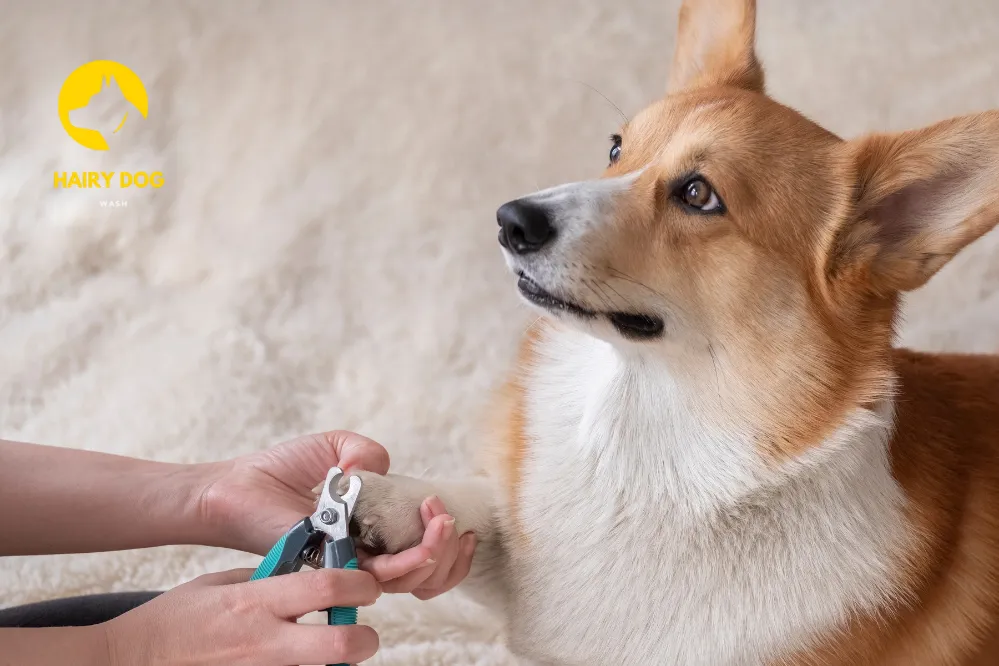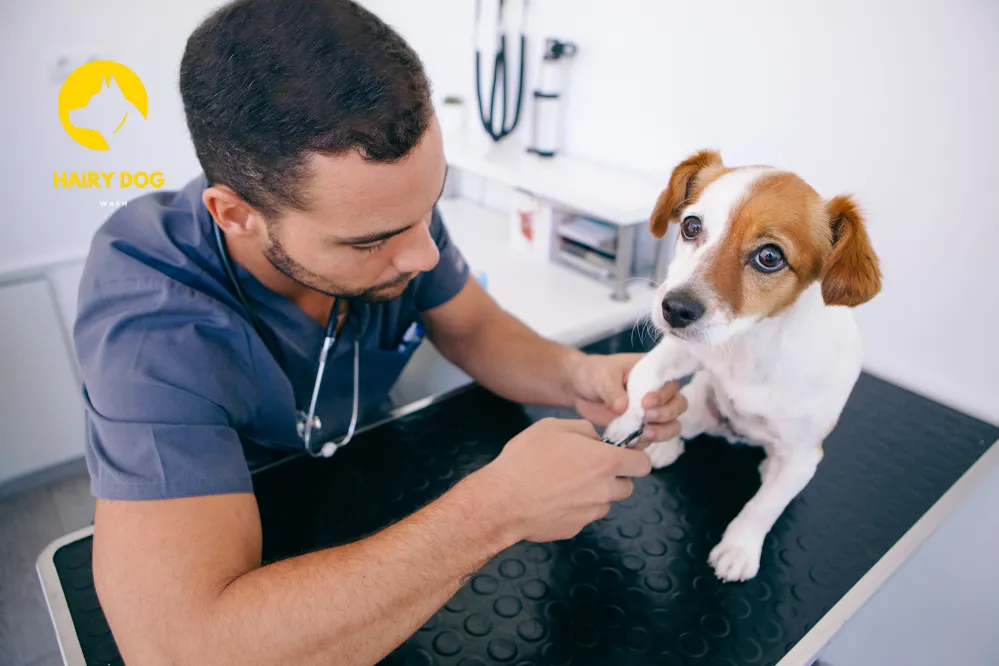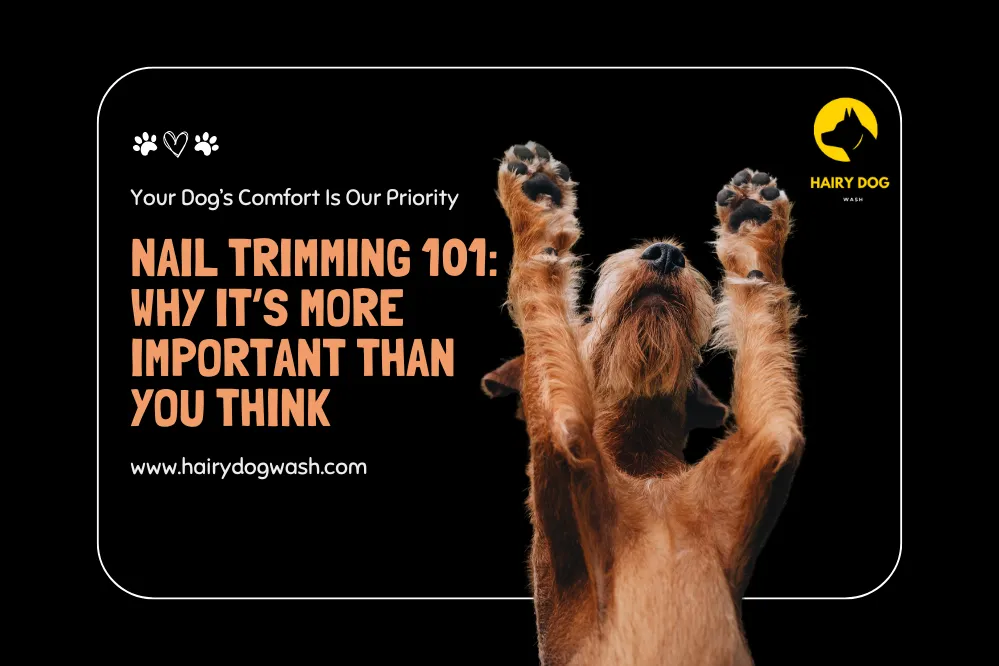Most pet owners know that grooming matters. Bathing. Brushing. Cleaning ears. But nail trimming? That often gets skipped. Some people think it’s not a big deal. Others feel scared to do it wrong. Some pets don’t like it either. So, it’s easy to avoid. But here’s the truth. Nail trimming is not optional. It is a basic need.
Overgrown nails hurt. They change how your dog walks. They cause joint pain. They may even lead to infections. Ignoring your dog’s nails is like ignoring your own shoes falling apart. It’s uncomfortable. Even dangerous.
This blog will tell you why nail trimming matters. You’ll learn how to spot signs that it’s time to trim. We’ll also cover what happens when you don’t. It’s more serious than you might think. Fleas, Ticks, and Mats: How Professional Grooming Helps Prevent Common Issues, read the full blog.
Why Nail Trimming Is So Important

A dog’s nails grow fast. In the wild, they would wear down naturally. But home pets don’t walk enough on hard surfaces. Their nails grow longer and longer. If not trimmed, the nail starts to curve.
That curve can push into the paw pad. It’s painful. It can bleed. It may cause infection. Long nails also affect posture. Dogs start walking oddly. This puts stress on their joints and spine.
Nails that tap on the floor are too long. You may think that’s normal. But it’s not. That clicking sound means your dog’s nails are already past a healthy length.
What Happens If You Skip Nail Trimming?

If you delay nail trimming too long, these problems may occur:
1. Pain and Discomfort
Long nails press into the ground. Each step causes pressure and pain. Your dog might limp or walk slowly.
2. Change in Posture
To avoid pain, your dog changes how it stands. This affects leg and spine health. Over time, it causes lasting damage.
3. Broken or Split Nails
Long nails get caught in carpets or cracks. They can rip off, break, or bleed. These wounds are painful and prone to infection.
4. Infections
If the nail grows into the paw pad, it can break the skin. Germs get in. That means swelling, redness, and a trip to the vet.
5. Behavior Changes
Dogs in pain may become aggressive. They may avoid walks. They may whine or hide more than usual.
Signs It’s Time to Trim Your Dog’s Nails

You might not always notice the length. But here are clear signs your dog needs a trim:
1. You Hear Clicking Sounds on Hard Floors
This is the most obvious clue. If your dog’s nails click with every step, they’re too long.
2. Your Dog Is Slipping or Losing Balance
Long nails affect grip. Your dog may slide on smooth surfaces. That’s not just funny—it’s unsafe.
3. Nails Are Touching the Ground
Look from the side. If the nails touch the floor while standing, it’s trimming time.
4. Curled or Hooked Nails
Nails should be straight or only slightly curved. If you see a full hook, the nail is overgrown.
5. Your Dog Is Limping or Avoiding Walks
Pain from long nails might stop your dog from wanting to walk or play.
6. Swelling or Redness Near Nails
Check the base of the nail. If it looks sore or swollen, it may be infected or irritated.
How Often Should You Trim Your Dog’s Nails?
There’s no one-size-fits-all rule. It depends on your dog’s lifestyle, breed, and age. On average:
- Active dogs who walk on pavement may need trims every 4 to 6 weeks
- Small dogs or indoor dogs need trims every 2 to 4 weeks
- Senior dogs may need more frequent trims because they walk less
The key is regular checking. If in doubt, check every 2 weeks.
What About the Quick?
The quick is the pink part inside the nail. It holds blood vessels and nerves. If you cut it, it bleeds and hurts. This is what makes nail trimming scary for many owners.
But here’s the trick. Trimming nails often makes the quick shrink. This allows you to trim shorter over time. If you wait too long, the quick grows too. That limits how short you can cut. Signs Your Dog Needs a Grooming Session ASAP, read the full blog.
How to Trim Nails Safely at Home
If your dog allows it, you can trim nails yourself. Here’s a safe step-by-step method:
Step 1: Get the Right Tools
Use dog nail clippers. Choose a size that fits your dog. You can also use a nail grinder if your dog is okay with noise.
Step 2: Choose a Calm Time
Pick a quiet time. After a walk or meal is best. Your dog is likely to be relaxed.
Step 3: Hold the Paw Gently
Hold your dog’s paw firmly but gently. Spread the toes to get a clear view.
Step 4: Trim a Small Bit
Only cut the tip of the nail. Avoid cutting too deep. Look for the quick if your dog has clear nails. Stop before you reach it.
Step 5: Use Styptic Powder if You Cut the Quick
If you make a mistake and there’s bleeding, stay calm. Use styptic powder or cornstarch to stop it.
Step 6: Give Praise
Reward your dog with a treat and praise. Make nail trimming a positive experience.
When to See a Groomer or Vet
Some dogs hate nail trimming. Others wriggle too much. In these cases, don’t force it. It’s okay to get help. A professional groomer can do it quickly and safely. If your dog has already developed painful issues, see a vet first.
Some groomers also file the nails. This helps smooth out sharp edges. It also gives the quick more time to shrink if you do regular trims.
Breeds That Need Extra Nail Care
Some breeds need more attention than others. Here are a few:
- Small breeds like Chihuahuas often walk indoors and wear down nails less
- Sighthounds like Greyhounds have thin nails that grow fast
- Senior dogs or those with joint issues move less, so their nails grow unchecked
- Working dogs may need more frequent nail trims due to varied terrain
Always check your dog’s nails no matter the breed.
Myths About Dog Nail Trimming
Myth 1: “Dogs trim their nails naturally during walks.”
Only partly true. Pavement may help wear down front nails. But not always enough. Back nails and dewclaws often still need trimming.
Myth 2: “If I trim a little, it won’t help.”
Even small trims make a big difference. Regular trims shrink the quick and improve paw health.
Myth 3: “Nail trimming hurts the dog.”
Trimming the tip doesn’t hurt. Only hitting the quick does. When done right, nail trimming is safe and painless.
Other Signs Your Dog Needs Grooming
Nail trimming is one part of grooming. But there are other signs it’s time for a full grooming session:
- Matted fur
- Smelly ears
- Dirty or oily coat
- Tear stains
- Dirty paws
- Constant licking or scratching
Regular grooming keeps your dog clean and reduces health risks.
Final Thoughts
Don’t ignore nail care. It’s not just for looks. It’s about your dog’s comfort and long-term health. Long nails can cause pain, change how your dog walks, and lead to infections. Regular trimming helps prevent all that.
Check your dog’s nails often. Learn to trim them at home or schedule regular visits to a groomer. Either way, don’t wait until there’s a problem. Prevention is always better.
A well-groomed dog is a happy dog. And it all starts at the tips of their toes.

